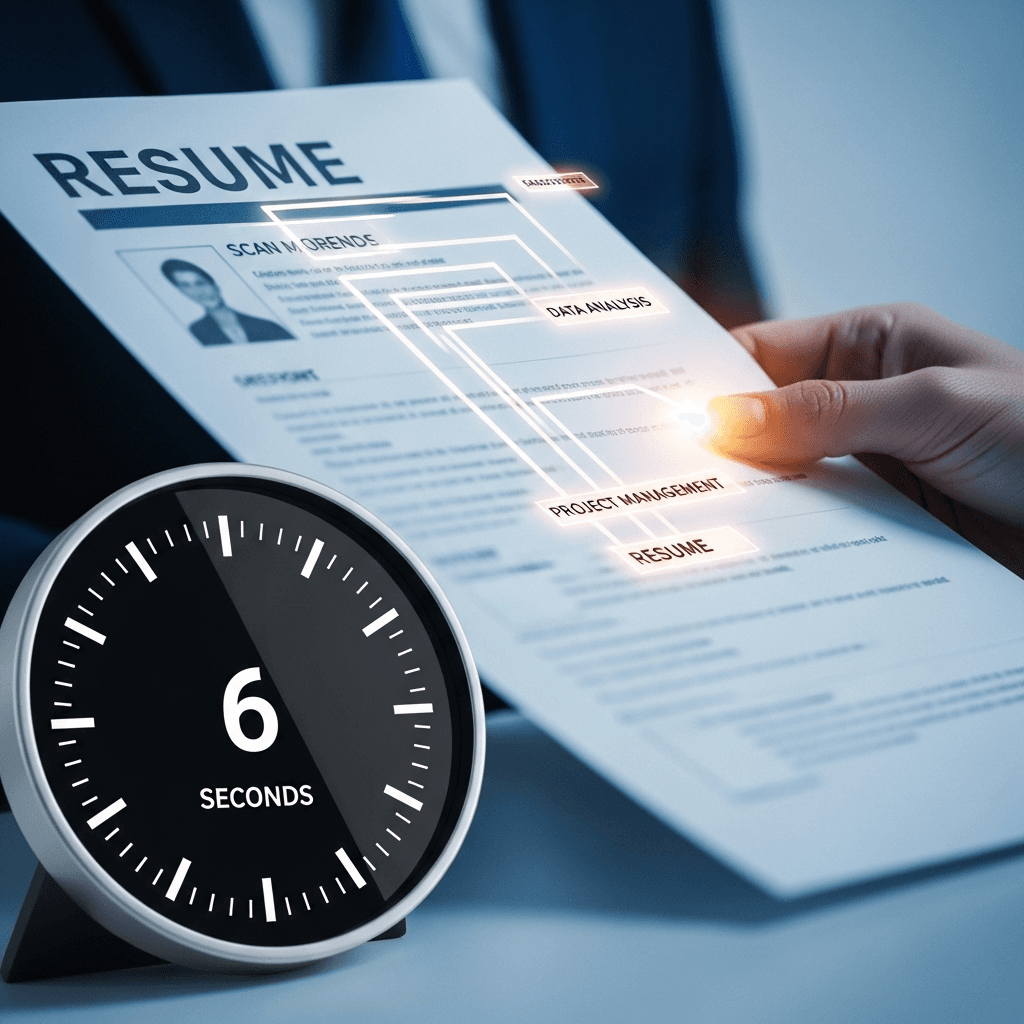Your Resume vs. a Goldfish's Attention Span: Who Wins?

You’ve spent hours, maybe even days, polishing your resume. You’ve agonized over every verb, debated the merits of the Oxford comma, and curated your experience into a masterpiece of professional history. It’s a work of art, a testament to your career, a document worthy of being framed. You hit "submit" and feel a surge of pride.
Ready for the ugly, soul-crushing truth? After all that effort, a human recruiter will spend approximately six to seven seconds looking at it. Yes, you read that right. You have less time to make an impression than it takes to decide what to watch on Netflix.
Don't despair. This isn't a personal attack on your life's work; it's the reality of a high-volume hiring process. The good news is that you can use this knowledge to your advantage. Welcome to the art of winning the 6-second resume scan. Let's dive into how to make every precious second count.
The Six-Second Scan: An Ode to Brutal Efficiency
Why So Little Time? It's Not You, It's Them.
Imagine a desk buried under a mountain of 250 resumes for a single job opening. The recruiter’s job isn't to savor each one like a fine wine. It's to rapidly triage them, sorting the "maybe" pile from the "definitely not" pile with the ruthless speed of a professional speed-dater. They aren't meticulously reading your eloquent prose; they're pattern-matching at the speed of light. They’re looking for specific clues that scream "this person might be worth another 30 seconds of my time." It's a game of rapid-fire elimination, and your first job is to not get eliminated.
The "F-Shaped" Gaze: Where Their Eyes Actually Go
Eye-tracking studies have revealed a dirty secret: recruiters don't read your resume; they scan it in a rough "F" shape.
They scan across the top.
They scan down the left-hand side of the page.
They might make another, shorter horizontal scan across the middle.
Everything else might as well be invisible. This is why formatting isn’t just about looking pretty; it’s a strategic weapon. If your most important information isn't at the top or on the left, it’s likely being ignored.
What They're *Actually* Looking For in Those Precious Seconds
So, if they're not admiring your font choice, what are they frantically searching for? Think of it as a high-stakes game of "I Spy" for grown-ups.
Job Titles & Company Names: Does your experience align with the role you're applying for? Are your titles recognizable? Your previous title was "Chief Happiness Officer"? Cute. But if you're applying for an HR Manager role, make sure that's clear.
Keywords, Keywords, Keywords: This is the holy grail. Before a human even sees your resume, it likely passed through an Applicant Tracking System (ATS) that scanned for keywords from the job description. The human recruiter is doing the exact same thing, just with their eyeballs. Sprinkle those magic words (e.g., "Project Management," "SaaS," "Data Analysis," "Agile Methodologies") throughout your experience.
Quantifiable Achievements: Numbers are shiny objects that catch a recruiter's eye. They cut through the fluff and show concrete value. Instead of "Managed social media accounts," try "Grew Instagram following by 300% to 50k and increased engagement by 25% in 6 months." One is a task; the other is a result.
Dates & Timelines: A quick glance at your employment dates shows career progression, stability, and any potential gaps. They’re checking to see if you've been job-hopping more than a kangaroo on a pogo stick.
Crafting the Perfect "Scannable" Resume: Your Survival Guide
Now that you know the rules of this ridiculous game, you can build a resume designed to win it. Forget writing a novel; you're creating a strategic marketing document.
The Non-Negotiable Sections (The "Must-Haves")
Contact Information: Your name in a large, bold font at the very top. Underneath, include your phone number, professional email address, and LinkedIn profile URL. Make it clean, clear, and impossible to miss. No one is hiring partyanimal2005@hotmail.com.
Professional Summary: Right below your contact info, write a 2-4 line "trailer" for your career. This is your elevator pitch. It should summarize who you are, what you do, and your key qualifications relevant to this specific job.
Work Experience: The main event. Use reverse-chronological order (most recent job first). For each role, use 3-5 bullet points that start with strong action verbs and focus on quantifiable achievements. Remember the F-shaped scan? Your most impressive accomplishments should be the first bullet point under each job.
Skills: A dedicated section with a clean, bulleted list or columns. This is your keyword goldmine. Separate hard skills (e.g., Python, Adobe Creative Suite, SQL) from soft skills (e.g., Leadership, Communication).
Education: Keep it brief. Your degree, your university, and your graduation year (if you're a recent grad). That's it. This goes at the bottom unless you just graduated.
The Sections to Ditch Immediately (Seriously, Let Them Go)
An Objective Statement: "My objective is to obtain a challenging position where I can utilize my skills..." We know. You applied for the job. This is outdated and wastes prime real estate at the top of your resume. Replace it with a powerful Professional Summary.
Your Full Mailing Address: City and State are fine. Your street address is not only unnecessary but also a potential security risk. They're not sending a carrier pigeon to your doorstep for an interview.
A Photo: Unless it's the standard in your country or industry (it's not in the US, UK, or Canada), a photo can introduce unconscious bias. Let your skills and experience speak for themselves.
"References Available Upon Request": Of course they are. This is the ultimate resume cliché. It’s like writing "I breathe oxygen" at the bottom. Use that space for another impressive skill or achievement.
Irrelevant Hobbies: Your passion for competitive cheese rolling is fascinating, but unless you're applying to be a professional cheese roller, it's just clutter. Keep it professional and relevant.
Your 6-Second Victory Lap
So, take a deep breath. Your resume isn't a sacred document chronicling your soul's journey. It’s a targeted advertisement designed to pass a 6-second test administered by a very busy, very caffeinated human.
Format it for a scan, pack it with quantifiable value, and align it perfectly with the job description. Do that, and you won’t just survive the 6-second glance—you’ll conquer it. Now go forth and win that interview. The recruiter is waiting... but not for long.


